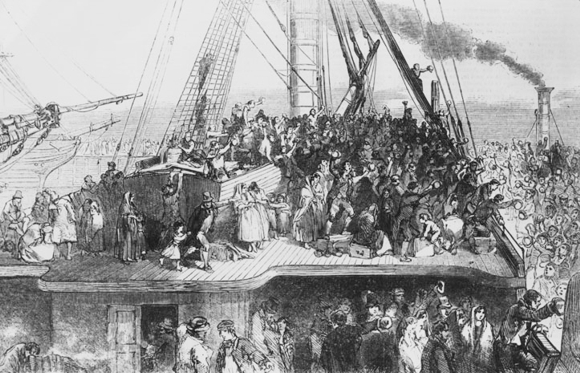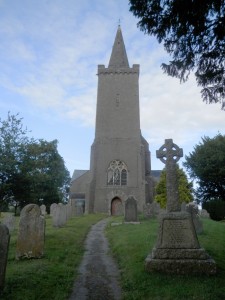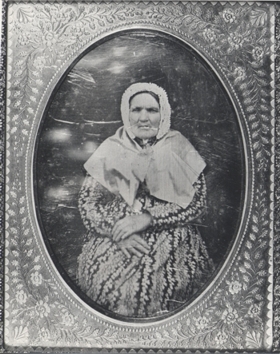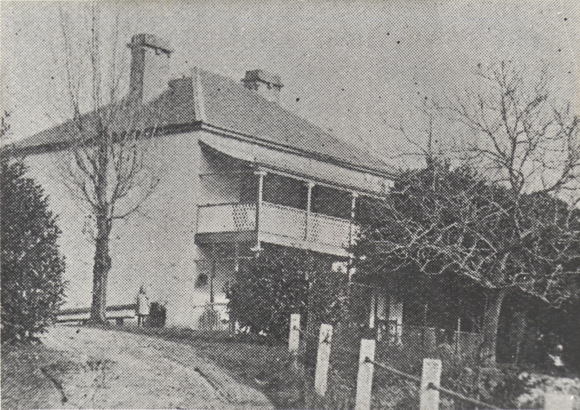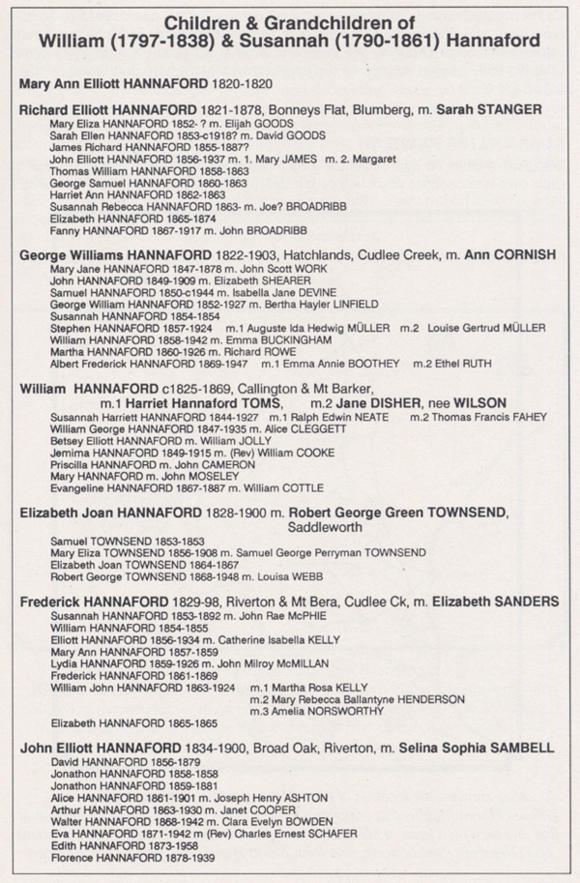Australia Day Blog Challenge: Climbing Your Family’s Gum Tree
I do love a good geneameme, so when Shauna Hicks posted her Australia Day post recently, which ended up being a revisit of an Australia Day Blog Challenge that was created by fellow Aussie geneablogger, Pauleen Cass a number of years ago, which apparently I missed … the challenge was on!!
Pauleen says …
“The geneameme is to test whether your family is ridgey-didge and to show us how Australia runs in your veins, without any flag-waving and tattoo-wearing. Shout it out, be proud and make everyone wish they lived in this wide brown land of ours.”
1. My first ancestor to arrive in Australia was …
Ok, if we count “what’s yours is mine” when you get married – Mr Lonetester’s convict, John Warby, who was given a free ticket to Australia in 1792, is my earliest ancestor. You can read more about him here. However ‘my’ own first ancestor would be Isaac and Simeon Richardson. They are two brothers who were labourers from Kent, and were sentenced to death for their part in local riots, however thanks to the local townsfolk, their life was spared, and instead they were transported to Van Diemen’s Land (for more click here). But my first non-convict ancestor was my Randell family from Devon to South Australia in 1837 (click for more details). Based on my Randell family, i’m 6th generation Australian.
2. I have Australian Royalty (tell us who, how many and which Fleet they arrived with) …
OK, I don’t have any first, second or even third fleet convicts, but I do have Australian Royalty.
Isaac RICHARDSON, transported 1831, Lord Lyndoch
Simeon RICHARDSON, transported 1831, Lord Lyndoch
William COSGROVE (still not 100% proven, but seems highly likely)
So that was my direct lot now on to Mr Lonetester’s gang of Australian Royalty …
John WARBY, transported 1792, Pitt
Sarah BENTLEY, transported 1795-06, Indispensible
Isaac DOWSE, transported 1802-03, Glatton
Esther Jane JENNER, transported 1807, Sydney Cove
Alexander MACDONALD, transported 1812-13, Fortune
Elizabeth SYMONS, transported 1814, Broxbornebury
James LAYTON, transported 1814-15, Marquis of Wellington
Charles BILLING, transported 1835, Norfolk
Frederick POINTON, transported 1836-37, Sarah
Henry POINTON, transported 1836-37, Sarah
Charles KERSLAKE, transported 1837, Moffatt
Sarah Jane BROWN, transported 1838-39, Majestic
Thomas POINTON, transported 1840, Lady Raffles
Isobel CUTHBERT, transported 1844, Margaret
Louisa WRIGHT, transported 1844-45, Garland Grove
James DODD, transported 1852-53, Oriental Queen
For more on all of these, head on over to this post.
3. I’m an Aussie mongrel, my ancestors came to Oz from…
Mostly England and Ireland, but there is also some German, Dutch and Finnish mixed in there.
4. Did any of your ancestors arrive under their own financial steam?
Pretty sure most of them made their own way here. Though see Q2 for the convicts who got a free ticket here, but then there’s also my great grandpa who was a seaman and jumped ship in Queensland!
5. How many ancestors came as singles?
You know , I’ve never actually counted! I will do that someday .. just not today
6. How many came as couples?
As above … I haven’t counted.
7. How many came as family groups?
I definitely know that some came out as families – such as my Hannaford’s and Randell’s from Devon, and the Phillips family from Cornwall. But people think travelling for a day or so on a plane with kids now is hard! Try 3 months in a ship!! I can’t even begin to imagine.
8. Did one person lead the way and others follow?
Hmmm … I know that happened with a family that went from Cornwall, England to the US. The dad went first, and was followed by his wife and kids later. But no-one comes to mind that came to Australia.
9. What’s the longest journey they took to get here?
For this one I need to go to Mr Lonetester’s family history again, as he has one that takes the cake! His William Kennard Elphick and his wife Susanna Elphick (nee Elliot), sailed on the ‘Plantar’ ship from London to South Australia in 171 days (25 November 1838 – 15 May 1839). Yes, that’s nearly SIX MONTHS!! Why did it take so long? Well thanks to a diary that a fellow passenger kept, and it’s been preserved … but with a mutiny, a lost crew, captain missing a key port and then almost running out of food, almost running aground … and so it goes on. Anything that could happen on a voyage, DID happen on this one. For more about it you can read my original post here. And the State Library of South Australia have digitised the original, and made it available online, which is viewable here.
10. Did anyone make a two-step emigration via another place?
Not that I know of.
11. Which state(s)/colony did your ancestors arrive?
Mine were pretty much all South Australian immigrants, apart from the convict brothers who went (and by went, I mean sent) to Tasmania.
12. Did they settle and remain in one state/colony?
Most of my reli’s came to South Australia, and certainly the greater portion of them stayed. A few of the wider then went off to different states, but my direct reli’s stayed!
13. Did they stay in one town or move around?
If we’re talking about my direct family – they settled in the Adelaide Hills, stayed there, and family (including myself) still live in the vicinity.
14. Do you have any First Australians in your tree?
Not that I’ve found so far.
15. Were any self-employed?
I think most of them were self-employed actually.
16. What occupations or industries did your earliest ancestors work in?
Farmers, Orchardists, Flour-millers, River-boat builders and captains, Fruit market sellers. That’s the ones that comes to mind at present …
17. Does anyone in the family still follow that occupation?
I have a cousin who is a 5th generation apple orcharder in the Adelaide Hills! So that’s seriously awesome.
18. Did any of your ancestors leave Australia and go “home”?
Not that I’ve found so far!
There were a few more questions in Pauleen’s original post, but that was about current stuff, not my ancestors, so I opted to leave those out for now. So that’s a little about some of my Australian ancestors …
Clearly there are some bits I need to do more research on – so I’ll add that to the to-do list, and I’ll get to it one day.
Emigration from England to South Australia in the 1800s
The “Mayflower” is ‘the ship’ in US history. The first ship to transport passengers from England to the United States in 1620. 102 people, all hoping to start a new life on the other side of the Atlantic.
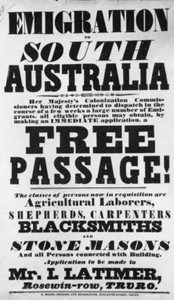 Well, in South Australian history the “Buffalo” is the equivalent. It was one of a fleet of ships to arrive in the colony at the end of 1836. Once it arrived at Glenelg, Governor John Hindmarsh who was on board, proclaimed the establishment of government in South Australia as a British province.
Well, in South Australian history the “Buffalo” is the equivalent. It was one of a fleet of ships to arrive in the colony at the end of 1836. Once it arrived at Glenelg, Governor John Hindmarsh who was on board, proclaimed the establishment of government in South Australia as a British province.
From then on, there was a big push to get skilled labourers from England to emigrate to the new colony, and as an enticement they were offered free passage (assisted passage). Of course there was still the option for anyone who wished to emigrate to pay their own way (known as unassisted passage), but many took up the offer of the emigration scheme, and as a result these pioneers helped make South Australia what it is today.
But as with anything that’s free, there were some rules and regulations.
I came across this list of rules for those wanting assisted passage in the West Briton and Cornwall Advertiser, dated 27 February 1839, and it’s truly fascinating.
RULES FOR EMIGRATION
- The Act of Parliament declares that the whole of the funds arising from the sale of lands, and the rent of pasture, shall form an Emigration Fund, to be employed in affording a free passage to the Colony from Great Britain and Ireland for poorer persons; “provided that they shall, as far as possible, be adult persons of both sexes in equal proportions, and not exceeding the age of 30 years.”
- With a view to carrying this provision into effect, the Commissioners offer a free passage to the Colony (including provisions and medical attendance during the voyage) to persons of the following description.
- Agricultural laborers, Shepherds, Bakers, Blacksmiths, Braziers, and Tinmen, Smiths, Shipwrights, Boat-builders, Butchers, Wheelwrights, Sawyers, Cabinetmakers, Coopers, Curriers, Farriers, Millwrights, Harness-makers, Lime-burners, and all persons engaged in the erection of buildings.
- Persons engaged in the above occupations, who may apply for a free passage to South Australia, must be able to give satisfactory references to show that they are honest, sober, industrious, and of general good character.
- They must be real laborers, going out to work for wages in the colony, of sound mind and body, not less than 15, nor more than 30 years of age, and married. The Marriage Certificate must be produced. The rule as to age is occasionally departed from in favour of the parents of large families.
- To the wives of such laborers as are then sent out, the Commissioners offer a free passage with their husbands.
- To single women a free passage will be granted, provided they go out under the protection of their parents, or near relatives, or under actual engagement as servants to ladies going as cabin passengers on board the same vessel. The preference will be give to those accustomed to farm and dairy work, to seamstresses, strawplatters, and domestic servants.
- The children of parents sent out by the Commissioners will receive a free passage, if they are under one, or fall 15 years of age at the time of embarkation. For all other children £5 each must be paid before embarkation by their parents or friends, or by the Parish. It will be useless to apply for a relaxation of this rule.
- Persons who are ineligible to be conveyed out by the Emigration Fund, if not disqualified on account of character, will be allowed to accompany the free Emigrants on paying to the commissioners the bare contract price of passage, which is usually between £15 and £17 for each adult person. The charges for children are as follows: under one year of age, no charge; one year of age but under seven, one-third of the charge for adults; seven years of age and under fourteen, one-half the charge for adults. A passage intermediate between a cabin and steerage passage may also be obtained of the Commissioners at a cost exceeding that of the steerage passage by one-half. Each intermediate passenger is entitled to half a cabin with some slight comforts in addition to those enjoyed by the steerage passengers.
- All Emigrants, adults as well as children, must have been vaccinated.
- Emigrants will, for the most part, embark at the Port of London, but if any considerable number should offer themselves in the neighbourhood of any port of Great Britain or Ireland, arrangement will, if possible, be made for their embarkation at such port.
- The expense of reaching the port of embarkation must be borne by the emigrants, but on the day appointed for their embarkation, they will be received, even though the departure of the ship should be delayed, and will be put to no further expense.
- Every adult Emigrant is allowed to take half-a-ton weight or twenty measured cubic feet of baggage. Extra baggage is liable to charge at the rate of £2.10s the ton.
- The Emigrants must provide the bedding for themselves and children, and the necessary tools of their own trades; the other articles most useful for emigrants to take with them, are strong plain clothing, or the materials for making clothes upon the passage. In providing clothing, it should be remembered that the usual length of the voyage is about four months.
- On the arrival of the Emigrants in the colony, they will be received by an Officer, who will supply their immediate wants, assist them in reaching the place of their destination, be ready to advise with them in case of difficulty, and at all times give them employment at reduced wages on the Government works, if from any cause they should be unable to obtain it elsewhere. The Emigrants will, however, be at perfect liberty to engage themselves to any one willing to employ them, and will make their own bargain for wages. This arrangement, while it leaves the Emigrant free to act as he may think right, manifestly renders it impossible for the Commissioners to give any exact information as to the amount of wages to be obtained; they can merely state that hitherto wages have been very much higher than in England.
So a free passage together with the social and economic conditions in England at the time, enticed our ancestors to pack up their whole life, spend four months on board a ship, travelling to an unknown country on the other side of the world, to start start again. We can’t imagine it can we.
The pioneers. They were brave beyond our understanding.
My First Hannaford Family in Australia
For Australia Day this year I decided to write about the Hannafords, who are one of my immigrating families. Or more specifically I should say, about Susannah Hannaford (nee Elliott), who is truly the matriarch of the family, and her children.
I admit I am in awe of Susannah, in some ways anyway. She was a widow by age 48, not an easy thing for anyone, but then to pack up all of your belongings and move to the other side of the world, to a colony that had only been founded a few years before, with her six children, leaving her family, friends and whole life behind, to start again from scratch. I can’t even begin to think of what that would be like or how she managed it. But she survived. So did her children, and now her descendants number the thousands.
But let’s go back a little bit first.
Back in Devon …
Susannah Elliott was born in 1790 in the market town of Totnes, in Devon, England. Meanwhile the Hannaford family (the ones I’m writing about anyway), grew up just four miles away in the little town of Rattery. I mention that as the Hannaford name in Devon is much like Smith or Brown everywhere else. Hannafords are everywhere!
When Susannah was 30 years old, she married William Hannaford (one from the neighbouring parish in Rattery), and who was actually a few years younger than her. Sadly William died at age 42, leaving Susannah with six children ranging in age from 17 down to 6.
Devon at that time (actually probably England at that time) had limited employment opportunities, and with high taxes (land tax and window tax for instance), it would seem that emigrating to a new land offered better prospects than staying in Devon.
The Voyage and Arrival …
So in 1840 Susannah and her clan together with 164 other passengers, boarded the “Brightman”, which was a three-masted barque which sailed from London, to Plymouth, and on to South Australia, making a quick voyage in just 106 days. Again, I can’t envisage what that would have been like. The closest I’ve been to this is a large cruise ship for 21 days which doesn’t even vaguely compare in any way whatsoever!
The Verco’s were also aboard the Brightman, and the following is an extract from the “Early Recollections of Sir Joseph Verco” which was written around 1930.
“The Brightman was a dry and comfortable ship. The bunks were arranged athwart ships along the sides of the vessel leaving a passage down the middle of the ‘tween decks. If in bed the passengers had to shift pillows from one end of the bunk to the other else he would be lying with his head down and his feet at a much higher level. Captain Nockells was a religious man conducting regular Sunday services, and he never failed to close with Psalm 139 verses 7-12. He would then invoke the blessing of God on the ship and those within, followed by the benediction. The Brightman made good passage of only 106 days. Keeping as much to the eastward as possible on the way south to avoid the dreaded Cap San Roque and its leeward currents. They sailed close round the Cape of Good Hope, then well to the north … and anchored in Holdfast Bay on 10 December 1840.
From the time of anchoring to the time of departure from the ship, there was a delay of seven days for some passengers. Boats transported the passengers and their luggage to land. Many floatable articles, such as wooden framed houses, manufactured and packed in England for immediate erection on landing in Australia, were simply tossed overboard and then tided to shire. All this took time and meant a long and tedious wait onboard for passengers.
When not concerned with the activity going on around them, those onboard found themselves preoccupied with thoughts of what awaited them beyond the shores amid the dense forest of trees and scrub … As it was they could see hundreds of natives moving along the shoreline. More than once they had been startled by the noise of a corroboree, one of which had been followed by fierce fighting resulting in many naked warriors being speared to death. Even at a distance it was somewhat frightening, but still more unnerving had been the screaming and yelling of the lubras as they mourned their dead.”
From the ship at Holdfast Bay (now Glenelg) it was a case of making the trip to Emigration Square in Adelaide, approximately 12 kilometers away, and with no roads. For many it was a case of walking the trip while for others they travelled by bullock dray. Emigration Square, situated on the Parklands, just west of Hindley Street contained 30-40 wooden huts in 1839-40, which were made for newly arrived emigrants to have a place to stay until they moved on.
Settling in South Australia …
The records show that the first house Susannah bought in South Australia was a 2 acre property at Unley in 1841. This was a small cottage and she established a mini farm on the land. By this time her two oldest two sons, Richard and George, went off cattle herding for the South Australian Company. And no doubt it was during one their travels that they heard of “fertile land with springs and running water 25 miles from Adelaide”. So George and his friend from the ship, James Verco, set out to find this land, and found it at Cudlee Creek, in the Adelaide Hills.
George was impressed with it, so much so that Susannah immediately bought land there, and in 1849 had a cottage built from stone quarried on the property. They named this property “Hatchlands” after the family property in Devon “Hatchland”. And this was the start of the Hannaford’s at Cudlee Creek. And today (six generations and 168 years later), they are still in the region.
As her family grew up and got their own properties, you will find descendants of Susannah’s living at Bonney’s Flat, Birdwood (Blumberg), Riverton, Saddleworth and of course Cudlee Creek (all in South Australia). And some of the property names associated with the family are ‘Broad Oak’, ‘Mount Bera’, ‘Riverside’, ‘Dingo Vale’, ‘Wattle Vale’, ‘The Briars’ and ‘Greenhills’.
The Hannaford’s have been heavily involved in the Fruitgrowers and Agricultural Associations for many years, and were known for their top class and prize winning apples. Some even winning international prizes. And I’m proud to say that today there are still family members running these generations-old apple orchards.
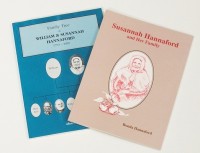 Of course Susannah and her family’s story doesn’t stop there. There are many achievements and noteworthy things from numerous descendants, but it’s too much for this post. But for anyone that does want more info on the family, I suggest getting a copy of both the following books, as they contain plenty of detail:
Of course Susannah and her family’s story doesn’t stop there. There are many achievements and noteworthy things from numerous descendants, but it’s too much for this post. But for anyone that does want more info on the family, I suggest getting a copy of both the following books, as they contain plenty of detail:
– Susannah Hannaford and her Family
– The Family Tree of William and Susannah Hannaford 1790-1990
This chart below shows Susannah and William Hannaford, their seven children (the first one died in infancy), together with their grandchildren. Seeing this you’ll understand WHY there are so many Hannaford’s around now.
Susannah Hannaford (1790-1861)
Truly a pioneer
And the matriarch of an incredible clan
Arriving on the ”Rajah” in 1849
As happens in those moments when you’re sitting in front of a computer and not reading or responding to emails, blogging or doing work … I went Googling, and decided to see what I could find on my Robbins family. Now this is a family that has received very little attention, so I’m pretty much starting from scratch. A few days earlier I had gone through a number of South Australian CDs that I have, and had begun piecing the family together, and I found out that they arrived on the “Rajah” in 1849.
This particular voyage of the “Rajah” left London on 30th August 1848, left Plymouth, Devon on the 9th September 1848, and arrived at Port Adelaide, South Australia on the 6th January 1849. No doubt not an easy trip for anyone, but it is one that so many of our ancestors made.

